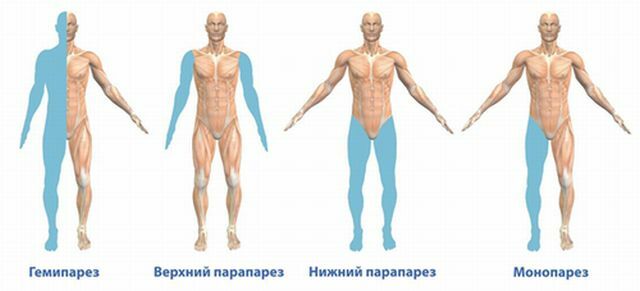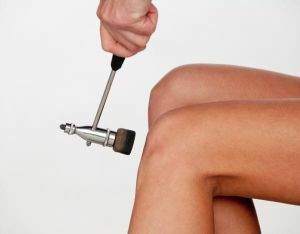 Reflex refers to the response of the body to environmental conditions or external irritation. These processes occur and are controlled by the activity of the nervous system.
Reflex refers to the response of the body to environmental conditions or external irritation. These processes occur and are controlled by the activity of the nervous system.
But it is worth considering that the reflexes are divided into different species that carry out a variety of reactions in the body. Thus, reflexes are usually divided into superficial and deep. If the surface ones are responsible for a small number of reactions, then the deep ones, on the contrary, control most of them.
The examination of reflexes in neurology allows not only to determine the extent of the affected area of the central and peripheral motoneutron, but also the level of disorders in the region of the spinal cord and brain. In neurology, the reflexes are divided into reactions of the surface and deep types.
Reflexes of superficial appearance are responsible for reactions of the skin, mucous membranes of the cornea of the eyes, and deep ones due to the reactions of muscle fibers, periosteum, tendons, joints. Deep reflexes are much more diverse and are responsible for multiple reactions in the body.
What are deep reflexes of
Deep-type reflexes are considered involuntary contractions of the muscles that act as a response to a stimulus containing muscular spindle receptors. This process occurs in the form of involuntary contractions of muscles with stretching of tendons of a passive nature.
Often this type of stretching is determined during a small abrupt impact at the place of the tendons attachments to the muscles, which is performed by a special neurological hammer. When determining the reaction, the patient should take a relaxed state, avoid stress, stiffness.
In this case, all muscle tissue should be completely relaxed, otherwise it will be impossible to determine the presence and extent of a particular reflex. If the patient has tension in one part or another of the musculature, he will pull the muscle, then the reflex will be inaccurate or even disappear.
If the reaction occurs with difficulty, the doctor asks the patient to distract himself from the place of study, for example, when examining the reactions of the legs, he is asked to tighten his teeth tightly, or to couple the fingers on both hands and force to pull his hands to the sides, this is called the reception of Endrasik.
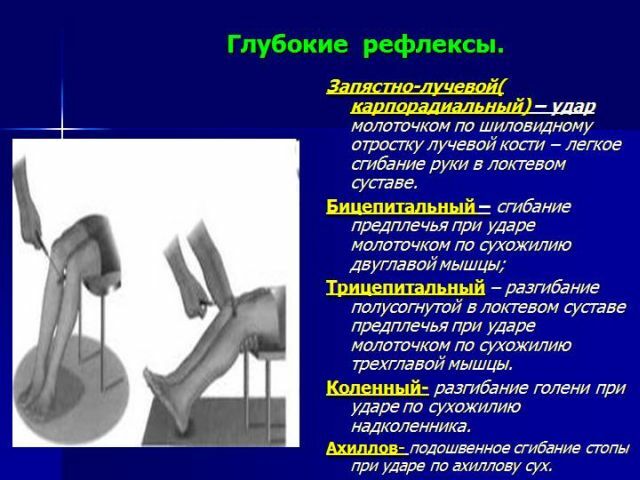
Degree of detection of deep reflexes is usually assessed by a ball system:
- 4 points - maximized reaction;
- 3 points - brisk, but it has normal expression;
- 2 points - the reaction is evaluated, in which the expression is normal;
- 1 point - low;
- 0 баллов - full absence.
The severity of reactions in healthy patients can vary greatly. Usually, the reactions in the leg area are of high severity and are caused much easier than reactions on the hands.
Not always a mild manifestation of bilateral reactions may be evidence of a disruption of the pyramidal nervous system, this reaction can occur in healthy people who have a high degree of excitability of the nervous system.
Tendon and periosteal reflexes
Deep reflexes are divided into several groups, namely:
- The tendon reflexes are unconditioned reactions that are triggered by a special neurological mallet in the place with the attachment of the tendon to the area of the muscle fibers. These are mitotic reflexes, because they are based on the process of stretching not the tendons, but the muscles, which is due to the stretching of the tendons.
- Reflexes of periosteal species refer to unconditioned ones. Reactions of this type occur during the stretching of the muscles that arise in response to the excitation of the periosteum receptors. Reactions of this species are manifested when a neurological hammer strikes.
Species of tendon reflexes
One of the most informative tendon reflexes is the Achilles. His challenge occurs during the impact of a neurological mallet on a site with an Achilles tendon. As a result, there is a contraction and bending of the foot. This reflex is called by several methods, namely:
- The patient should sit .He sits on his knees on the surface of a couch or chair. In this case, the feet should hang freely
- The patient lies down on the abdominal region .During this, the doctor with his left hand should take both feet of the patient by the fingers and restrain them at a right angle to the shin.
- The patient should take the condition lying on the back of the .His leg should bend in the area of large joints with the rotation of her outward. After this, the foot is bent in the rear direction and a blow is made. During this procedure, a reaction occurs in the form of plantar flexion of the foot.
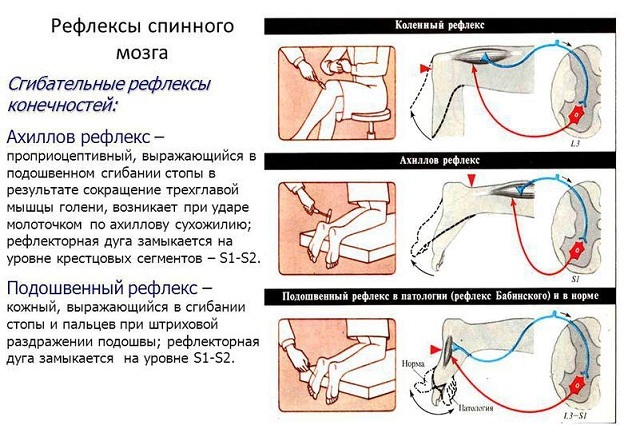
Other known tendon reflexes:
- Flexion-lobe reaction .This reaction is manifested when the impact on the phalanx of the specialist's thumb is placed on the surface of the elbow of the patient. At the same time he presses his finger on the area with a tendon of the biceps muscle, which is located at the point of the elbow bend. At the time of this procedure, the patient's arm should take a semi-bent position in the elbow joint site, and the forearm zone must be completely relaxed and placed on the surface of the thigh. This reaction is accompanied by motor reactions, which manifest themselves by flexing the arm at the site of the elbow joint. Extension of the elbow reflex .It manifests itself during a hammer blow in the place with the tendon of the arm of the triceps
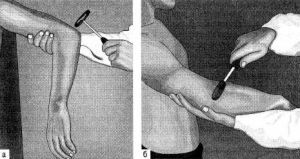 , which is 1.5-2 cm above the process in the elbow bone. During the implementation of this procedure, the patient's arm should be taken just above the elbow over the shoulder area and held in this state. During the definition of this reflex, the process of extension of the arm in the zone of the elbow joint is observed.
, which is 1.5-2 cm above the process in the elbow bone. During the implementation of this procedure, the patient's arm should be taken just above the elbow over the shoulder area and held in this state. During the definition of this reflex, the process of extension of the arm in the zone of the elbow joint is observed. - Response of the knee or pelvis type ( knee-jerk reflex).This reaction occurs when the hammer is exposed to the tendon of the quadriceps muscle, which is located below the calyx. As a result, a reduction reaction is observed and then the shin is unbent. The reaction is triggered by two methods: the first method - the patient assumes a prone position, while the doctor turns his hand under his knee, which takes a bent state at an obtuse angle, the second method - the patient must sit deeply, and his legs must hang down at the same time. The process of disinhibition of the reaction is performed with the help of Endrassic. During this appointment, the patient is advised to perform pinch of the fingers and stretch them to the sides with an effort. During the check of this reflex, an extension of the leg in the knee joint is observed.
- The fasciculation of is an involuntary jittering of individual muscle regions, which occurs when there is no general contraction of the whole muscle. This reduction is due to a spontaneous contraction of the muscle group. In order to reveal the presence of fasciculation, a thorough examination of the patient with a maximum concentration of attention on the hypotrophic and paretic muscle fibers is carried out. During the examination, the patient lies on his back and relaxes as much as possible. Examination should be carried out in a warm room.
- fibrillations are spontaneous contractions of individual areas of muscle fibers. Unlike the previous reflex, fibrillation is not determined visually. Electromyography is used for their detection.

Reflex arc of the knee reflex
Periosteal reactions
Periosteal( periosteal) reflexes:
- Reaction of the superciliary type ( superciliary reflex).It is defined during percussion by a hammer along the edges of the area in the region of the brow. As a result, motor reactions are observed in the form of eyelid closing.
- Bekhterev reflex of the mandibular or mandibular type ( mandibular reflex).It is observed when the
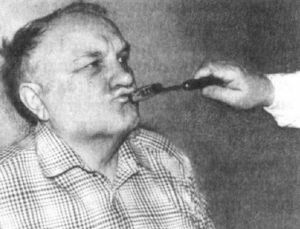 is struck with a hammer on the lower edge of the chin, and the patient should slightly open his mouth. As a result, there is a motor response, which is accompanied by contractions of the chewing muscles, and they in turn cause the jaws to close.
is struck with a hammer on the lower edge of the chin, and the patient should slightly open his mouth. As a result, there is a motor response, which is accompanied by contractions of the chewing muscles, and they in turn cause the jaws to close. - Scapular-brachial reaction of ankylosing spondylitis .The reflex is determined by percussion using a neurological tool along the edge of the scapula. During this procedure, the patient's arm should be in a loose dangling state. As a result of this process, a response must occur in the form of bringing the arm and rotating it outward. At the same time, the afferent and efferent sections of the reflex arc pass in the zones of the subscapular and supilar-nerve nerves. Closure of the reflex arc is observed in C5-C6 segments of the spinal cord. This kind of reflex was described as far back as 1902 by A.V.Bekhterev.
- Deep abdominal reaction of ankylosing spondylitis .Also called as a bone-abdominal reflex. This type of reaction is caused by a special neurological hammer at the edge of the costal arch, which is located close enough to the teat line, closer to the center. As a result, there is a response to this type of reflex in the form of spasm of muscle fibers at the site of stimulation. The closure of the reflex arc is observed at the level of 7 and 12 thoracic parts of the spinal cord.
- Deep abdominal reaction of Triumfus .The reflex can be triggered with a special hammer on the pubic area 1-1.5 cm from the middle line on the right or left side. During the procedure, there is a response motor reaction, in which there is a process of contraction of muscle fibers, located on the side of the front abdominal wall in place with irritation. Closure of the reflex arc is observed at the level of the seventh thoracic region in the spinal cord.
- Carpodial reflex ( carpal-ray reaction).This type of reaction is manifested during the impact with a hammer on the
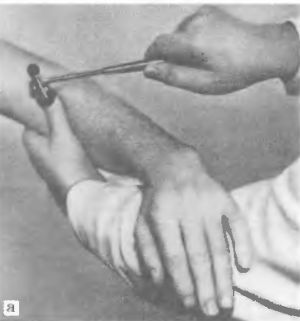 area of the styloid process of the radius. During this process the patient must bend his arm. In this case, the hand should be located in the area between pronation and supination, and the brush should assume a free state, it is placed on the surface of the thigh. Reaction can be detected using two methods: In prone position. During this method, the patient assumes a prone position, while he must bend his hands in the area of the elbow joints, and he places his hands on the abdominal surface. In standing position. With this method, the patient assumes a standing position, while he bends not to the end of the arm at the site of the elbow joint. The doctor must hold the patient's arms in the desired semi-prone position.
area of the styloid process of the radius. During this process the patient must bend his arm. In this case, the hand should be located in the area between pronation and supination, and the brush should assume a free state, it is placed on the surface of the thigh. Reaction can be detected using two methods: In prone position. During this method, the patient assumes a prone position, while he must bend his hands in the area of the elbow joints, and he places his hands on the abdominal surface. In standing position. With this method, the patient assumes a standing position, while he bends not to the end of the arm at the site of the elbow joint. The doctor must hold the patient's arms in the desired semi-prone position.
During examination of deep reflexes in the arm area, it is necessary to carefully examine the site with the spread of the reflex reaction. For example, if a carporadial reflex is called, then the fingers of the wrist may appear, this process will indicate the presence of a lesion in the central motoneutron.
There is an inversion or process of distortion of the reflex - when instead of the double-headed, the process of contraction of the triceps muscle of the shoulder is manifested. This disorder arises from the spread of excitation to the neighboring parts of the spinal cord, while the patient also has disorders in the anterior spine region that intervenes the biceps muscle region.
During this process, there must be a response motor reaction to this reflex, which is accompanied by flexion and rotation of the arm at the site of the elbow joint, while simultaneous bending of the fingers is observed.

